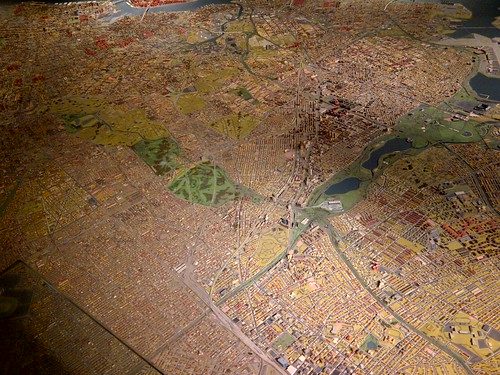The Jewish Museum is using this photo in their subway ad for one of their current exhibitions and I knew I had to go:

The exhibition is The Radical Camera: New York’s Photo League, 1936-1951 and is running through March 25th. The Photo League was a group of photographers (mostly Jewish) who shot documentary style and sought to make social and political change through photography. The group itself, along with many of the photographers, was blacklisted in the 1950s. The photographers included Berenice Abbott, Sid Grossman, Lisette Model, Aaron Siskind, Paul Strand, and Weegee.
I got to the museum at about 2:30pm on Sunday and it was packed. I only managed to see about a third of the exhibition. I wanted to see more but the line was very slow-moving and I can’t stand in front of a photograph for that long. I did look through the catalog and I recommend buying it. I’m not sure when the museum is less crowded but when I was leaving at 4pm there was still a long line of people coming in and the museum closed at 5pm.
One of the more interesting stories was from a Life photo essay: “Maude Callen, Nurse Midwife.” Callen worked in a rural section of South Carolina. Besides birthing babies, the nurse helped those with disabilities cash their checks and get groceries and brought clothing to those in need. After the article appeared readers of the magazine donated enough money for Callen to build a clinic.
I went upstairs to check out the other exhibits. Composed: Identity, Politics, Sex had four very interesting photos by Debbie Grossman . They were old WPA photos in color. One was a rancher shooting at a chicken hawk and another was of a farm family sitting around the dinner table. If you looked closely, all the adults were women. Grossman has used Photoshop to modify the photos and create a town of women.

The permanent exhibit is Culture and Continuity: The Jewish Journey, which takes us through the story of Jewish culture from the beginning to present-day. There are some amazing ancient pieces and there’s a room filled with menorahs from around the world. There’s one corner that has pieces and photos from the Holocaust. There is a video of Yom HaShoah and you watch as everyone stands still for two minutes while the siren blasts. While I was in there a father called out to his 12yo daughter to come in – once in the space she said, “Oh yeah, we read like four books on this,” and I realized that this really is ancient history for some. I don’t know if she was Jewish but I remember growing up and my father and my friends’ fathers had served in WWII and some of our mothers were Rosie the Riveter. That war was discussed in homes and on TV. And it wasn’t unusual to see people with numbers tattooed on their arms. I don’t remember anyone ever explaining it to me – I always knew what it meant.
So I was disappointed not to fully see the exhibit I went to the Jewish Museum to see but I enjoyed what I did get to see.
By Carene Lydia Lopez

